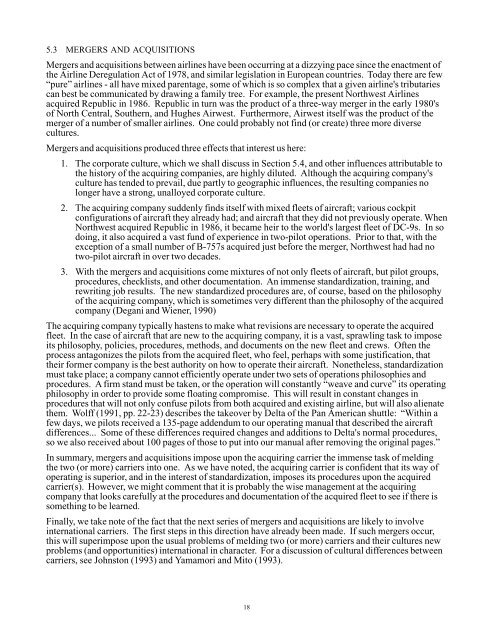On the Design of Flight-Deck Procedures - Intelligent Systems ...
On the Design of Flight-Deck Procedures - Intelligent Systems ...
On the Design of Flight-Deck Procedures - Intelligent Systems ...
Create successful ePaper yourself
Turn your PDF publications into a flip-book with our unique Google optimized e-Paper software.
5.3 MERGERS AND ACQUISITIONSMergers and acquisitions between airlines have been occurring at a dizzying pace since <strong>the</strong> enactment <strong>of</strong><strong>the</strong> Airline Deregulation Act <strong>of</strong> 1978, and similar legislation in European countries. Today <strong>the</strong>re are few“pure” airlines - all have mixed parentage, some <strong>of</strong> which is so complex that a given airline's tributariescan best be communicated by drawing a family tree. For example, <strong>the</strong> present Northwest Airlinesacquired Republic in 1986. Republic in turn was <strong>the</strong> product <strong>of</strong> a three-way merger in <strong>the</strong> early 1980's<strong>of</strong> North Central, Sou<strong>the</strong>rn, and Hughes Airwest. Fur<strong>the</strong>rmore, Airwest itself was <strong>the</strong> product <strong>of</strong> <strong>the</strong>merger <strong>of</strong> a number <strong>of</strong> smaller airlines. <strong>On</strong>e could probably not find (or create) three more diversecultures.Mergers and acquisitions produced three effects that interest us here:1. The corporate culture, which we shall discuss in Section 5.4, and o<strong>the</strong>r influences attributable to<strong>the</strong> history <strong>of</strong> <strong>the</strong> acquiring companies, are highly diluted. Although <strong>the</strong> acquiring company'sculture has tended to prevail, due partly to geographic influences, <strong>the</strong> resulting companies nolonger have a strong, unalloyed corporate culture.2. The acquiring company suddenly finds itself with mixed fleets <strong>of</strong> aircraft; various cockpitconfigurations <strong>of</strong> aircraft <strong>the</strong>y already had; and aircraft that <strong>the</strong>y did not previously operate. WhenNorthwest acquired Republic in 1986, it became heir to <strong>the</strong> world's largest fleet <strong>of</strong> DC-9s. In sodoing, it also acquired a vast fund <strong>of</strong> experience in two-pilot operations. Prior to that, with <strong>the</strong>exception <strong>of</strong> a small number <strong>of</strong> B-757s acquired just before <strong>the</strong> merger, Northwest had had notwo-pilot aircraft in over two decades.3. With <strong>the</strong> mergers and acquisitions come mixtures <strong>of</strong> not only fleets <strong>of</strong> aircraft, but pilot groups,procedures, checklists, and o<strong>the</strong>r documentation. An immense standardization, training, andrewriting job results. The new standardized procedures are, <strong>of</strong> course, based on <strong>the</strong> philosophy<strong>of</strong> <strong>the</strong> acquiring company, which is sometimes very different than <strong>the</strong> philosophy <strong>of</strong> <strong>the</strong> acquiredcompany (Degani and Wiener, 1990)The acquiring company typically hastens to make what revisions are necessary to operate <strong>the</strong> acquiredfleet. In <strong>the</strong> case <strong>of</strong> aircraft that are new to <strong>the</strong> acquiring company, it is a vast, sprawling task to imposeits philosophy, policies, procedures, methods, and documents on <strong>the</strong> new fleet and crews. Often <strong>the</strong>process antagonizes <strong>the</strong> pilots from <strong>the</strong> acquired fleet, who feel, perhaps with some justification, that<strong>the</strong>ir former company is <strong>the</strong> best authority on how to operate <strong>the</strong>ir aircraft. None<strong>the</strong>less, standardizationmust take place; a company cannot efficiently operate under two sets <strong>of</strong> operations philosophies andprocedures. A firm stand must be taken, or <strong>the</strong> operation will constantly “weave and curve” its operatingphilosophy in order to provide some floating compromise. This will result in constant changes inprocedures that will not only confuse pilots from both acquired and existing airline, but will also alienate<strong>the</strong>m. Wolff (1991, pp. 22-23) describes <strong>the</strong> takeover by Delta <strong>of</strong> <strong>the</strong> Pan American shuttle: “Within afew days, we pilots received a 135-page addendum to our operating manual that described <strong>the</strong> aircraftdifferences... Some <strong>of</strong> <strong>the</strong>se differences required changes and additions to Delta's normal procedures,so we also received about 100 pages <strong>of</strong> those to put into our manual after removing <strong>the</strong> original pages.”In summary, mergers and acquisitions impose upon <strong>the</strong> acquiring carrier <strong>the</strong> immense task <strong>of</strong> melding<strong>the</strong> two (or more) carriers into one. As we have noted, <strong>the</strong> acquiring carrier is confident that its way <strong>of</strong>operating is superior, and in <strong>the</strong> interest <strong>of</strong> standardization, imposes its procedures upon <strong>the</strong> acquiredcarrier(s). However, we might comment that it is probably <strong>the</strong> wise management at <strong>the</strong> acquiringcompany that looks carefully at <strong>the</strong> procedures and documentation <strong>of</strong> <strong>the</strong> acquired fleet to see if <strong>the</strong>re issomething to be learned.Finally, we take note <strong>of</strong> <strong>the</strong> fact that <strong>the</strong> next series <strong>of</strong> mergers and acquisitions are likely to involveinternational carriers. The first steps in this direction have already been made. If such mergers occur,this will superimpose upon <strong>the</strong> usual problems <strong>of</strong> melding two (or more) carriers and <strong>the</strong>ir cultures newproblems (and opportunities) international in character. For a discussion <strong>of</strong> cultural differences betweencarriers, see Johnston (1993) and Yamamori and Mito (1993).18
















